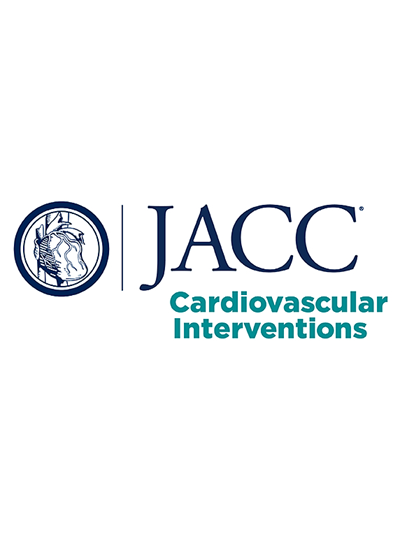FFR与非充血压比不一致病变的预后
IF 11.7
1区 医学
Q1 CARDIAC & CARDIOVASCULAR SYSTEMS
引用次数: 0
摘要
大约20%的临床病例可能出现血流储备分数(FFR)和非充血压比(nhpr)之间的不一致,这在心导管实验室中造成了治疗困境。目的:作者试图进行一项系统综述和荟萃分析,调查发现生理不一致的患者采用延期治疗策略的长期结果。方法初步比较生理不一致延迟患者与生理不一致延迟患者的长期预后。将不同nhpr与FFR进行比较。主要终点是死亡(全因或心脏)和心肌梗死/血运重建术的复合终点。次要终点包括死亡或心肌梗死。该研究已在PROSPERO注册(CRD42024628393)。结果在分析中考虑了6项符合条件的试验9854例延迟PCI的中间病变。与生理一致阴性患者(FFR−/NHPRs−)相比,生理不一致患者延迟PCI治疗与主要终点增加相关(FFR−/NHPRs+: HR: 2.73 [1.95-3.80];P & lt;0.00001, FFR+/NHPRs−:HR: 3.29[2.33-4.64];P & lt;0.00001)。二次二分法分析显示,与生理上一致阴性的患者相比,两个不一致组的PCI延期与硬终点(死亡或心肌梗死)的增加有关。在生理不一致的情况下,比较血运重建组和延迟组的探索性分析表明,FFR+/NHPRs -组的主要终点有所减少,但FFR - /NHPRs+组则没有。结论生理不一致者与生理不一致者相比,延迟PCI治疗远期预后较差。在FFR+/NHPRs−病变中可能存在血运重建的益处,这需要进一步的研究。本文章由计算机程序翻译,如有差异,请以英文原文为准。
Outcomes of Lesions With Discordance Between FFR and Nonhyperemic Pressure Ratios
Background
Discordance between fractional flow reserve (FFR) and nonhyperemic pressure ratios (NHPRs) can occur in about 20% of clinical cases, creating treatment dilemmas in the cardiac catheterization laboratory.
Objectives
The authors sought to perform a systematic review and meta-analyses investigating the long-term outcome of deferral strategy in patients found to have discordant physiology.
Methods
The primary comparison tested the long-term prognosis of patients who were deferred for discordant physiology vs those deferred for concordant negative results. Various NHPRs were compared with FFR. The primary endpoint was a composite of death (all-cause or cardiac) and myocardial infarction/revascularization with several definitions. Secondary endpoint consisted of death or myocardial infarction. The study is registered with PROSPERO (CRD42024628393).
Results
Six eligible trials with 9,854 intermediate lesions deferred for PCI were considered in the analysis. Compared with concordant-negative physiology (FFR−/NHPRs−), deferral of PCI for discordant physiology was associated with an increase in the primary endpoints (FFR−/NHPRs+: HR: 2.73 [1.95-3.80]; P < 0.00001 and FFR+/NHPRs−: HR: 3.29[2.33-4.64]; P < 0.00001). Secondary dichotomous analysis showed that deferral of PCI in both discordant groups was associated with an increase in the hard endpoints (death or myocardial infarction) compared with concordant-negative physiology. Exploratory analysis comparing revascularization vs deferral groups within discordant physiology demonstrated reduction in the primary endpoint in the FFR+/NHPRs− group, but not in the FFR−/NHPRs+ group.
Conclusions
Deferral of PCI in discordant-physiology was associated with worse long-term outcomes compared with the concordant-negative physiology. There may be a benefit of revascularization in FFR+/NHPRs− lesions, which requires further investigation.
求助全文
通过发布文献求助,成功后即可免费获取论文全文。
去求助
来源期刊

JACC. Cardiovascular interventions
CARDIAC & CARDIOVASCULAR SYSTEMS-
CiteScore
11.60
自引率
8.80%
发文量
756
审稿时长
4-8 weeks
期刊介绍:
JACC: Cardiovascular Interventions is a specialist journal launched by the Journal of the American College of Cardiology (JACC). It covers the entire field of interventional cardiovascular medicine, including cardiac, peripheral, and cerebrovascular interventions. The journal publishes studies that will impact the practice of interventional cardiovascular medicine, including clinical trials, experimental studies, and in-depth discussions by respected experts. To enhance visual understanding, the journal is published both in print and electronically, utilizing the latest technologies.
 求助内容:
求助内容: 应助结果提醒方式:
应助结果提醒方式:


